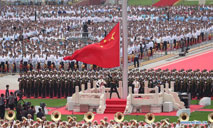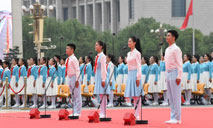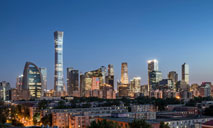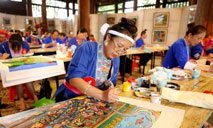70 years after taking wings, China's first fighter jet maker cruises high
SHENYANG, June 29 (Xinhua) -- China's first fighter jet manufacturer, Shenyang Aircraft Corporation (SAC), celebrated its 70th anniversary on Tuesday.
The birth of the SAC, also referred to as plant No.112 ever since, marks the beginning of the aviation industry of the People's Republic of China (PRC) founded in 1949.
Based in Shenyang, capital of northeast China's Liaoning Province, the SAC has become one of the backbone enterprises of the Aviation Industry Corporation of China (AVIC), with more than 15,000 staff.
BORN TO DEFEND
On June 29, 1951, the fighter plant was built out of a hangar that served the Chinese People's Volunteer Army taking part in the War to Resist U.S. Aggression and Aid Korea (1950-1953).
This was the first step the young PRC took to build its own aviation industry with an investment worth 6 billion jin (3 million tonnes) of millets, then equivalent to 600 million yuan (nearly 93 million U.S. dollars).
In the 1940s when China was fighting the war against Japanese invasion and in the early 1950s, millet was used as a unit of measurement of fiscal revenue and expenditure to cope with price fluctuations.
No.112 was among the 156 key projects listed in China's first five-year plan from 1953 to 1957. A flood of young scientists, technicians, and skilled workers from across the country joined No.112, and the employee strength surged to around 10,000 in 1955.
Under on-the-spot guidance by Soviet Union specialists, No.112 succeeded in manufacturing PRC's first fighter jet, the J-5, which had its maiden flight on July 19, 1956.
"We were extremely excited," recalled Tang Qiansan, 88, former general manager of the SAC. "Because then our country was not capable of producing a vehicle, let alone an aircraft."
"We were all very encouraged and proud of ourselves that we did it! We made a contribution to the country. Our hard work paid off," said Tang, who joined No.112 in 1952.
The J-5 was more than a fighter to the PRC.
"The successful trial production of this fighter has not only armed the air force and enhanced its combat effectiveness, but also promoted the development of relevant industries and scientific research departments, such as the metallurgy and electronic industries, and the materials research and aerodynamics research institutes," Niu Yinguan once wrote in a recollection article. He was the head of No.112 in 1955-1960.
"China has therefore taken a big step forward in terms of industrial progress. The significance of J-5 is far from being limited to No.112 alone," Niu wrote.
CRADLE OF MORE THAN FIGHTERS
Over the decades, the SAC, dubbed the "cradle of China's fighter jets", has manufactured more than 40 types of fighter planes, including China's first self-developed fighter jet trainer, first supersonic fighter jet, first high-altitude high-speed fighter jet, and the first carrier-based fighter.
From imitating the Soviet Union's fighters at the beginning to independently designing its own products, the SAC has developed into a modern aircraft manufacturer engaged in R&D, production, testing, trial flights, and service guarantee.
Before its 70th anniversary, Tang and some senior retirees were invited to the SAC.
"It is so different now," said Tang, who retired 24 years ago.
"The equipment, the products, the software, and the management have all changed dramatically," he said. "Hope the SAC will keep going and close the gap with the world's leading aviation enterprises."
As one of the first aircraft factories, the SAC has been supporting the establishment of new factories since its early days. More than 20,000 people from the SAC have relocated to southwest and northwest China with equipment and technology, where they helped build plants for fighter jets, helicopters, bombers, seaplanes, and missiles.
People with the SAC would be pleased to share an anecdote: the organization sent a team to take part in a basketball match between teams from the aviation industry held in Xi'an years ago. The spectators quickly split into two groups: young people cheering for the local team, and the grey-haired cheering for the SAC. The excited older spectators were no doubt former SAC employees.
PRACTICE MAKES PERFECT, BRINGS RESPECT
Among the 1,000-plus exhibits in the SAC museum, a wood hammer triggers curiosity among visitors. More than 60 years ago, it was with this ordinary tool that Chen Ayu, a skilled worker, cautiously adjusted several deformed parts during the manufacture of J-5. Thanks to his creative solution to the problems, the production plan was not delayed and everyone's effort was not wasted.
The legend has inspired more engineers and technicians to be enthusiastic and innovative.
Tang Chensheng, 57, a senior engineer with the machinery and AI team, has never stopped learning since he joined the SAC in 1988.
Among the 55 patents he received for his inventions, a new tool machining technology helped improve the processing efficiency and accuracy. It won him a golden award at China's international inventions exhibition held in Shanghai in 2004.
The aviation industry not only requires mechanized operations but also manual skills. Some parts, such as bench work, still have to be done by hand.
Yang Guoxin, 27, a bench worker, compared his job to "making and building blocks". Unlike many of his peers, Yang was not interested in playing games but keen to participate in skill competitions.
"Every contestant has his or her own merits. I enjoy learning from them," he said.
As a result of winning awards in competitions, he was promoted to be the youngest senior technician in the SAC at the age of 21. Usually it takes more than 20 years for technicians to reach this position.
A star SAC employee, Yang would be occasionally mistaken for a taxi driver when he showed up in his uniform shirt in downtown Shenyang.
In contrast to the SAC's low profile, its products draw attention.
Prior to the anniversary, the SAC museum exhibited an FC31 in its fighter theme park. The aircraft has drawn visitors and triggered online discussion.
Jia Mulin travelled from Beijing to take a look at the dark-colored fighter jet.
"I'm crazy about airplanes. This is the first time I have seen the advanced fighter so closely," said Jia, 29, a financial industry employee in Beijing.
Born and raised in Shenyang, Jia would bring his visiting friends to the museum whenever possible and brief them on the history of the SAC and talk about aviation.
"Over the years, the SAC has encountered difficulties and zigzagged out of hardships," he said, "but it deserves respect for its striving spirit and entrepreneurship."
"As a Shenyang local, I'll always be proud of the SAC and I wish it a bright future," he said.
Photos
Related Stories
Copyright © 2021 People's Daily Online. All Rights Reserved.










